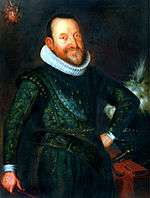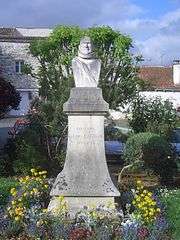Agrippa d'Aubigné
| Agrippa d'Aubigné | |
|---|---|
 | |
| Born |
8 February 1552 Château de Saint-Maury (now Charente-Maritime), France |
| Died |
29 April 1630 (aged 78) Geneva, Switzerland |
| Occupation | Poet, soldier |
| Nationality | French |
| Period | 16th century |
| Genre | Poetry |
| French literature |
|---|
| by category |
| French literary history |
| French writers |
|
| Portals |
|
Théodore-Agrippa d'Aubigné (8 February 1552 – 29 April 1630) was a French poet, soldier, propagandist and chronicler. His epic poem Les Tragiques (1616) is widely regarded as his masterpiece.[1]
Life
Born at the Aubigné Château of Saint-Maury near Pons in the present day Charente-Maritime, the son of Jean d'Aubigné, who was implicated in the Huguenot Amboise conspiracy to kidnap the King (1560). According to his own account he knew Latin, Greek and Hebrew at six years of age, and he had translated the Crito of Plato before he was eleven. His father strengthened his Protestant sympathies by showing him, while they were passing through that town on their way to Paris, the heads of the conspirators exposed upon the scaffold, and instructing him not to spare his own head in order to avenge their death.[2]
After a brief residence he was obliged to flee from Paris to avoid persecution, but was captured and threatened with death. Escaping through the intervention of a friend, he went to Montargis. In his fourteenth year he was present at the siege of Orléans, at which his father was killed.[2]
In 1567 he made his escape from tutelage, and attached himself to the Huguenot army under the prince of Condé. Aubigné studied in Paris, Orléans, Geneva (under the tutelage of Theodore Beza) and Lyon before joining the Huguenot cause of Henry of Navarre (Henry IV) as both soldier and counsellor. After a furious battle at Casteljaloux, and suffering from fever from his wounds, he wrote his Tragiques in 1571. He was in the battle of Coutras (1587), and at the siege of Paris (1590). His career at camp and court, however, was a somewhat chequered one, owing to the roughness of his manner and the keenness of his criticisms, which made him many enemies and severely tried the king's patience. In his tragédie-ballet Circe (1576) he did not hesitate to indulge in the most outspoken sarcasm against the king and other members of the royal family.[2]
Henry's accession to the throne of France entailed an, at least nominal, conversion to the Roman Catholic Church and Aubigné left his service to tend to his own Poitou estates, even though his Huguenot confederates welcomed Henry's religious tolerance. However he never entirely lost the favour of Henry, who made him governor of Maillezais. d'Aubigné remained true to the Huguenot cause, and a fearless advocate of the Huguenot interests. The first two volumes of the work by which he is best known, his Histoire universelle depuis 1550 jusqu'à l'an 1601, appeared in 1616 and 1618 respectively. The third volume was published in 1619, but, being still more free and personal in its satire than those which had preceded it, it was immediately ordered to be burned by the common hangman.[2]
When Marie de' Medici became regent following Henry's assassination in 1610, she embraced the Counter-Reformation and Aubigné's isolation made him an easy target. He was proscribed in 1620 and fled to Geneva where he lived for the rest of his life, though the hatred of the French court showed itself in procuring a sentence of death to be recorded against him more than once. He devoted the period of his exile to study, and supervising the fortifications of Bern and Basel which were designed as a material defence of the cause of Protestantism.[2]
Legacy
His daughter Louise Arthemise d'Aubigné, Madame de Villette, was born in 1584 at Mursay to Suzanne de Lusignan de Lezay; at an early age on 22 October 1610 she married Benjamin Valois de Vilette in Maillezais.
His son, Constant d'Aubigné, led a scandalous life of adventure; still, his son Theodore (1613–1670) continued on the d'Aubigné line. Between his two sons, and then later his three grandsons, the family eventually sailed to England in the late 1680s, or America, avoiding the Huguenot persecution in Europe. Later in 1715 or thereabouts, most if not all of the main family had sailed to the new world and settled on the east coast near the North River around Falls Church, Virginia, and changed their name to Dabney. His great grand daughter Françoise Charlotte d'Aubigné married into the House of Noailles.
Literary and historical works
- Histoire universelle (1616–1618)
- Les Tragiques (1616)
- Avantures du Baron de Faeneste
- Confession catholique du sieur de Sancy
- Sa vie à ses enfants
Les Tragiques
Written over some three decades, the alexandrine verse of this epic poem relies on multiple genres as well as stylistic familiarity with the work of the opposing, Catholic poets of the Pléïade, headed by Pierre de Ronsard. Divided into seven books, a number symbolic of the author's ultimate, apocalyptic intent, the Tragiques incorporates literary influence from classical sources, such as tragedy and satire, palpable in the first three books ("Les Misères," "Les Princes" and "La Chambre Dorée" respectively), before resorting to influence from genres like ecclesiastical history, martyrology and apocalypse in the creation of the remaining books ("Les Feux," "Les Fers," "Vengeances," and "Jugement").
In the first of two liminal paratexts, the introduction "Aux Lecteurs," Aubigné endorses the account (also found in his autobiographical Sa Vie à Ses Enfants), that the inception of the Tragiques came to him as an ecstatic vision during a near-death experience. In the second, "L'Auteur À Son Livre," Aubigné adopts the metaphor of father as author to name the text that follows (Les Tragiques) as a more pious son than the less religious works of his youth (c.f.: Le Printemps). The intent of the epic is subsequently spelled out as an attack against the falsely beautiful, verisimilar works written by the Catholic poets of the Pléïade for their patrons in the midst of the religious wars.

Notes
- ↑ A colloquy featuring Aubigné and the poets of his generation, Une volée de poètes : D’Aubigné et la génération poétique des années 1570-1610 organised by Association des Amis d’Agrippa d’Aubigné is scheduled for October 2008 at Laboratoire Forell (Université de Poitiers) (Colloquy website Archived April 20, 2008, at the Wayback Machine.).
- 1 2 3 4 5

References
- Linden, Paul, Voice and Witnessing in Agrippa d'Aubigné's Les Tragiques. Dissertation, Emory University, 2003.
- Fragonard, Marie-Madeleine, La pensée religieuse d’Agrippa d’Aubigné et son expression. Bibliothèque littéraire de la Renaissance 53 (Paris: Honoré Champion, 2004).
- Junod, Samuel, Agrippa d'Aubigné ou les misères du prophète, (Geneva: Droz), 2008.
External links
| Wikimedia Commons has media related to Agrippa d'Aubigné. |
- Works by or about Agrippa d'Aubigné at Internet Archive
- Biography (in French)
- http://www.agrippadaubigne.org/ (in French)
- Les Tragiques. (French Ebook PDF format, layout and fonts inspired by 17th century publications)